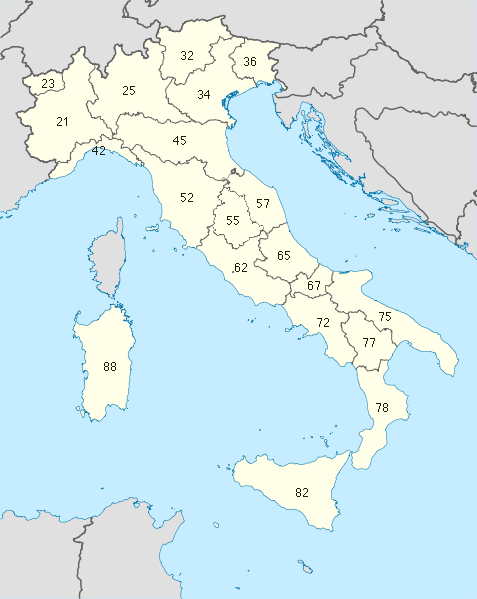Italy
Italian unification ws a process that evolved over a long period starting with the Congress of Vienna 1815 and largely completed by the Franco-Prussian War 1871. In 1861 the King of Sardinia assumed the title King of Italy as Victor Emanuel II.
The modern regions of Italy are as depicted in the following map together with their status in 1815.
| Region |
Code |
Capital |
Status in 1815 |
 |
| |
|
|
|
| |
|
|
|
| Abruzzo |
65 |
L'Aquila
|
Kingdom of the Two Sicilies |
| Aosta Valley |
23 |
Aosta |
Kingdom of Sardinia |
| Basilicata |
77 |
Potenza |
Kingdom of the Two Sicilies |
| Calabria |
78 |
Catanzaro |
Kingdom of the Two Sicilies |
| Campania |
72 |
Naples |
Kingdom of the Two Sicilies |
| Emilia-Romagna |
45 |
Bologna |
Papal States; Duchy of Parma; Duchy of Modena |
| Friuli-Venezia Giulia |
36 |
TriesteLazio |
Kingdom of Lombardy-Venetia |
| Lazio |
62 |
Rome |
Papal States |
| Liguria |
42 |
Genoa |
Kingdom of Sardinia |
| Lombardy |
25 |
Milan |
Kingdom of Lombardy–Venetia |
| Le Marche |
57 |
Ancona |
Papal States |
| Molise |
67 |
Campobasso |
Kingdom of the Two Sicilies |
| Piedmont |
21 |
Turin |
Kingdom of Sardinia |
| Puglia |
75 |
Bari |
Kingdom of the Two Sicilies |
| Sardinia |
88 |
Cagliari
|
KIngdom of Sardinia |
| Sicily |
82 |
Palermo |
Kingdom of the Two Sicilies |
| Tuscany |
52 |
Florence |
Grand Duchy of Tuscany; Duchy of Lucca |
| Trentino-Alto Adige |
32 |
Trento |
Kingdom of Lombardy-Venetia |
| Umbria |
55 |
Perugia |
Papal States |
| Veneto |
34 |
Venice |
Kingdom of Lombardy-Venetia |
| |
|
|
|
To find records, you must know the town where your ancestor lived. You also need to determine the parish that your ancestorís town was located in so you know which parish registers to search. Larger towns frequently have more than one parish. Church records were kept at the local parish church. Sometimes duplicates can be found at the central archives of the diocese. This was formalised in 1900. Unfortunately some Italian church records were destroyed in the various wars over the centuries. Italy has no single repository for church records. If the baptism, marriage, and burial records have not been filmed by FamilySearch, you will have to contact the local parish or archive in Italy. Parishes will sometimes answer correspondence but do not expect the parish you contact will. Address your letter: Il parroco di [name of parish, town, province] Italy.
Civil registering of births, marriages, and deaths began in 1809 in areas occupied by France (see the page on French research) but it was not until 1866 that civil registration became law across Italy. After Napoleon’s defeat in 1815, many areas discontinued civil registration. These records were and are kept at the local registrar’s office in each town. A duplicate record is kept by the district court in the provincial capital. To obtain civil registration records, you can write to the town. Civil officials will usually reply if you observe the following conditions. Your request may be forwarded if the records have been sent to the provincial capital. All requests must be written in Italian. You should note that Italian registrars are not required by law to assist in genealogical research work and unless complete and correct information is provided, no search will be undertaken. You must enclose an International Reply Coupon. Modify the format provided by the US State Department: Birth, Marriage, Death.
|